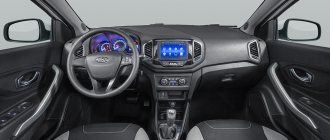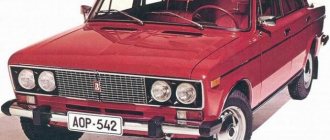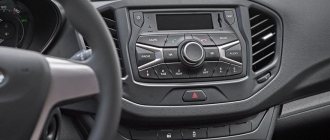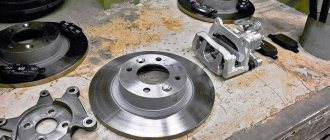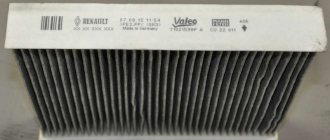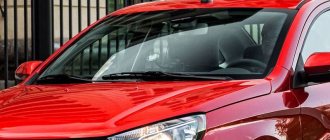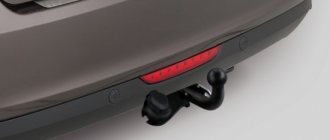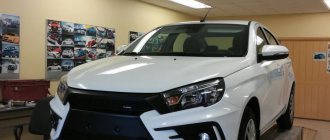Today it demonstrates enviable progress, delighting its fans with new and promising models that can successfully compete with foreign cars. A striking new product that has been seriously talked about in the global automotive arena is the Lada Vesta. Only the best constructive ideas and solutions that can be found today among foreign manufacturers are reflected in this “Russian”.
Probably, many will be interested: where is the Lada Vesta car assembled? In what city? Therefore, today we will talk specifically about this topic.
Start of production of Lada Vesta
September 2015. A model still unknown to the general public, the Lada Vesta, is launched into production. After a couple of months on the assembly line, the first copies appear on sale. Experts are very skeptical about the start of implementation, predicting the Lada Vesta will be the same failure as its predecessors.
However, over time the picture became completely different. Lada Vesta began to be bought up in large quantities, which became a reason to compare it with the best foreign cars on the market in the budget niche.
How did the manufacturer manage to succeed so much? It's simple: thanks to high consumer qualities, including:
- affordability;
- ergonomic and cozy interior;
- competitive and attractive exterior;
- capacity;
- the presence of modern assistant systems (ESP, ABS, etc.);
- fairly high degree of safety (2 airbags).
Where is the people's car assembled? Novaya Vesta is produced in Izhevsk. It also produces the Granta in the liftback version. The production of the new model was not without the participation of Renault engineers. They assisted in the design of the body, which was recreated using modern software. As a result of this interaction, Vesta’s body frame is not inferior in strength to the famous Ford Focus. The first crash tests have already confirmed this fact. In what city is the popular car in Russia still assembled?
Disadvantages of Lada Vesta SW Cross
- New instrument panel. She's beautiful, orange lighting, that's all. But let's face it, she's blind. Everything is hard to see on it. That is, the scales in the wells are too deep and too high. And the backlight here is very dim and it’s quite difficult to read.
- Next, a huge problem is AMT. The worst thing is that Auto VAZ considers AMT a successful product, despite the fact that 100% of journalists tell them that it is just a nightmare. This robot is simply not designed to be used properly.
- Multimedia system. As we noted above, the screen backlight is very dim. The sun will shine a little and you can no longer see anything.
Assembly and painting of a domestic model
Where is the car assembled and finalized? Welding of the main body elements is carried out using advanced robotic equipment. Although this process minimizes the influence of the human factor, it could not be done without the presence of qualified assemblers. Each stage of the assembly line takes place with the participation of workers. They hang the body panels, attach the remaining frame elements, which are subsequently welded using robotic technology.
Previously, the quality of painting of domestic bodies caused a lot of indignation among buyers. Today the situation is different. For painting Lada Vesta Cross purchases materials from global manufacturers - leaders in this market segment. Technological methods of painting, drying, polishing and other processes are constantly being improved.
The welded body is initially dipped into a special tank filled with an anti-corrosion solution. Then comes the stage of treatment with catapharesis primer. A significant proportion of these manipulations are performed by automation, but qualified painters perform their work in those places where clumsy robotics cannot get close.
Removing the Kalina torpedo
The fuel pump does not work on Kalina
Speed sensor Kalina 8 valves
Half a hundred from above
Jatco is used even on the cheapest modifications. Minimum - 736,900 rubles for a CVT sedan, maximum - 982,900 rubles for SW Cross with a CVT and all options. Competitors are on average 80,000–120,000 rubles more expensive with similar power and a similar level of equipment.
Only 9% of Vesta buyers chose cars with an AMT robot. And for Kia and Hyundai, almost three quarters of sales are versions with automatic transmission: even in the budget segment, people are willing to pay extra for comfort.
Now Lada has opportunities for growth. Marketers expect to increase the share of versions with a CVT to at least 30%.
I wonder if the next step would be to install a 150-horsepower 1.3 turbo engine from Arcana on Vesta? It would reveal all the capabilities of the chassis! In 2021, Vesta will receive a restyling, and who knows?
According to official data, Vesta with a CVT is the fastest of the “automated” versions of the model. The 1.6 CVT sedan accelerates to hundreds faster than the 1.8 AMT version by 0.8 seconds (11.3 versus 12.1), the station wagon - by 1.1 seconds (12.2 versus 13.3). Subjectively, the version with a 122-horsepower engine drives more vigorously.
| Better for the city than AMT | High fuel consumption |
The final stage for Vesta
- At all stages of the production cycle, continuous supervision is carried out by engineering and technical personnel. The quality of a particular operation is checked.
- The developers took quite a lot of care about the level of equipment and the quality of the interior. Here you can see soundproofing and anti-vibration materials, which are present not only on the panels, but also applied to the bottom.
- The final stage of the assembly cycle of the Lada Vesta Cross today is little different from a similar process among foreign automakers. Upon completion of the painting work, the doors are dismantled again and sent to a special workshop, where they are finalized to a finished state.
- After installing the headlights, bumpers and other components, the body is mated to the suspension, powertrain and transmission line. Note that, in part, domestic developers use the foreign experience of world leaders in the auto industry.
- Today, the manufacturer does not intend to stop there and promises to expand the line with the introduction of a hatchback and a station wagon, in the same place where sedans are already produced.
It's not a Zhigul: off-road test drive of LADA Vesta SW Cross
The new Vesta is also tested on a test track with six types of surfaces, which are most often found in our open spaces. There are “combs”, “cobblestones”, and “speed bumps”. In all this, they check not so much the car’s suspension, but rather the quality of the build - creaks, extraneous noises, etc.
There is another unusual approach: the so-called AVES (Alliance Vehicle Estimation Standard). Here the inspector examines selected cars from the lot with the pickiness of a future buyer, literally stroking him from all sides.
PHILOSOPHY OF EFFICIENCY or THERE IS NO LIMIT TO PERFECTION
Since the end of 2012, the plant has been practicing the “kaizen” philosophy. It is based on the Japanese production philosophy, which means constant improvement and obtaining maximum effect at minimum cost. For the production process, this means, first of all, a reduction in labor intensity, an increase in the efficiency of using working time, and, as a consequence, an increase in labor productivity and a reduction in costs.
For example, the plant’s specialists developed and implemented a number of interesting solutions: synchronized conveyors for supplying components, automatic body grippers. Almost all production facilities use automatic trolleys that deliver the necessary parts to the line along given routes.
By the way, you will learn a lot of interesting things about the assembly of LADA from our video.
Constant improvement, increased ergonomics, cleanliness and order in the production premises and at each workplace, clean work clothes, controlled movements of personnel, nothing more - this is to explain in a nutshell what the implemented production system is. It is important that continuous improvement and a clean plant are in the minds of every plant employee. The team actively implements kaizens, bringing their workplaces to ideal ergonomics.
Let's sum it up
Many will ask: does the Lada Vesta Cross plan to be assembled somewhere other than Izhevsk? Yes! Assembly production at ChechenAvto is being established. The company is located in Argun. Also, Kazakh colleagues will soon begin cooperation with Tolyatti residents, since assembly will soon begin in Ust-Kamenogorsk at the facilities of BipekAvto, where other cars are also produced. Now you have become familiar with where Vesta is collected.
So, according to experts, today’s strategy of the Russian auto giant is correct, and it is not known in what city the model will be assembled in the future!
History of the car plant in Izhevsk
A little about the plant: since 1965, they produced Moskvich, Izh-Oda, VAZ classics, heels, then Kia, which will be discussed in a separate article, because I managed to visit the museum of the enterprise.
After the 2008 crisis, things went really badly - the company laid off employees, there was no work, and bankruptcy took place. In 2010, there was a plan to start producing Koreans again, but there was a sleight of hand and the enterprise was bought by AvtoVAZ, albeit with money from the federal budget (that is, ours), as a result, production was modernized with this money, the production of Grants began, this happened until 2021 year, when the plant refocused on producing Vesta.
At the moment, only Vestas are produced at this plant; 107,000 of them are assembled per year, which is not so little. But, of course, before Soviet times the numbers didn’t even come close. Well, despite the cheerful figures in the statistics - they say the production and sales of West are growing, revenue is growing, the share of Lada is growing, everything is not so simple, the fact is that with revenue growth, production costs are growing much faster (and there will also be a separate article about this ), this is due to the fact that many spare parts are imported, and the ruble, as you know, is falling and falling, in addition, this is due to the huge general inefficiency of the enterprise, a large amount of manual labor.
As a result, for 2021, the losses of Lada Izhevsk almost reached a billion rubles; in 18-19, apparently (no data yet), it will be at the level of one and a half billion. Accounts payable - 8.5 billion, at the end of the year will be at the level of 10 billion, accounts receivable - almost 7 billion rubles. That is, at the moment there are many times more debts than assets. All this data is publicly available in the quarterly reports of both AvtoVAZ and Lada Izhevsk, you can check it.
In principle, in a competitive economy this means only one thing - bankruptcy of the enterprise and its closure. But.. we live in an amazing country, therefore, with the help of injecting our money into the economy of a Japanese-French enterprise (who doesn’t know, AvtoVAZ, which owns the Lada Izhevsk, itself belongs to the Renault-Nissan-Mitsubihsi alliance and is a foreign company that owns in our country there is only an assembly plant) the enterprise exists and in such conditions is trying to develop, which, in principle, turns out: there is growth, but losses are still growing...
Part 2
The factory has a mini conveyor for doors. The doors are assembled separately from the body, as in other global car factories. This reduces labor intensity, improves quality and productivity. At the end of the line, the doors are installed on the same body from which they were removed.
The ring conveyor, which has a total of 9 trolleys, allows you to simultaneously install the rear beam and the power unit module on the body.
Manipulators are devices that increase human strength many times over. For example, such devices are installed in the area where doors and instrument panels are installed on the body.
Other robots apply glue to windshields and rear windows. This process was entrusted to robots, because... they do this work more accurately and efficiently. The person just glues the glass onto the body.
The plant has a special area for checking the quality of the assembled car, which consists of five posts. These include adjustment of wheel geometry and headlights, a vehicle dynamic test stand, a wheel lateral slip test unit, an electronic control system tester and a leak test chamber. All cars, without exception, pass through the inspection line; the results of each stage of the inspection are recorded in a vehicle assembly control card, which is stored for at least five years. Also, quality control of all machines is checked by human inspectors.
